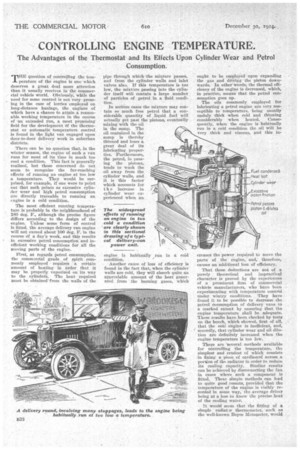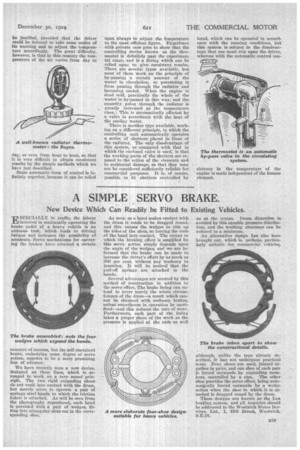CONTROLLING ENGINE TEMPERATURE.
Page 22

Page 23

If you've noticed an error in this article please click here to report it so we can fix it.
The Advantages of the Thermostat and Its Effects Upon Cylinder Wear and Petrol Consumption.
T"' question of .controlling the temperature of the engine" is one which deserves a great deal more attention than it usually receives in the commercial vehicle World. Obviously; while the need for some control is not very pressing in the case of lorries employed on long-distance haulage, the engines of which have a chance to attain a reasonable working temperature in the course of an extended run, a. most promising field for the development cif the thermostat or automatic temperature control is found in the light van engaged upon door-to-door delivery work in suburban districts.
There can be no question that, in the winter season, the engine of such a van runs for most of its time in much too cool a condition. This fact is 'generally realized, but those concerned do not seem to recognize the far-reaching effects of running an engine at too low a temperature. They would be surprised, for example, if one were to point out that such points as excessive cylin4er wear and high petrol consumption are directly traCeable to running an engine in a cold condition.
The most efficient running temperature is probably in the neighbourhood of 180 deg. F., although the precise figure differs according to the design of the engine. Unless some form of control is fitted, the average delivery van engine will not exeeed about 100 deg. F. in the course of a day's work, and this results in excessive petrol consumption and inefficient working conditions for all the moving parts of the engine.
First, as regards Petrol consumption, the commercial grade of spirit. commonly employed requires a certain amount of heating in order . that it may be properly vaporised on its way to the cylinders. The heat required must be obtained'from the walls of the pipe through which the mixture passes, and from the cylinder walls and inlet valves also. If this temperature is too low, the mixtare passing into the cylinder itself will contain a large number of particles of petrol in a fluid condition.
In seri6us cases the mixture may contain so much free petrol that a con
siderable quantity of liquid fuel will actually get past the pistons, eventually mixing with the oil in the sump. The oil contained in the sump is thereby thinned and loses a great deal of its lubricating properties. Furthermore, the petrol, in passing the pistons, tends to wash the oil away from the cylinder walls, and it is this factor which accounts for t h e increase in cylinder wear experienced when an
engine i3 habitually run in a cold condition.
-Another cause of loss of efficiency is found in the fact that, when the cylinder walls are cold, they will absorb quite an appreciable amount of the heat generated from the burning gases, which ought to be employed' upon expanding the gas and driiringthe piston downwards. In otherWords, the thermal efficiency of the engine is decreased, which, in practice, means. that the petrol consumption goes up.
The oils commonly employed for lubricating a petrol engine are very susceptible to temperature. being usually unduly thick when cold and thinning considerably when heated. Consequently, when the engine is habitually run in a cold condition the ,oil will be very thick and viscous, and this in
creases the power required to move the parts of the engine,. shd, therefore, causes an additional loss of efficiency.
That these deductions are not of a purely theoretical and impractical character isproved by the experiences of a prominent firm of commercial . vehicle manufacturers, who have been . experimenting with temperature contthi under, wintry conditions. They have found it to be possible to decrease the petrol consumption of delivery vans: to a marked extent by ensuring that the engine temperature shall be adequate. These results have been checked by tests on the bench, which showed, first of all, that the cold engine is inefficient, and, secondly, that cylinder wear and oil dilution are definitely increased when the engine temperature is too low.
There are -several methods available for controlling the temperature, the simplest and Crudest of which consists in fixing a piece of cardboard across a portion of the radiator in order to reduce its cooling capacity. Similar results can be achieved by disconnecting the fan. in cases where such a component is fitted. These simple methods can lead to quite good .tesuits, provided that the temperature of the engine is visibly recorded in some way, the average driver being at a less to _know the precise heat of the cooling water.
it would seem that the fitting or it simple radiatir therniometer, such as the well-known Boyce Pfrotometer,
be justified, provided that the driver could be induced to take some notice of its warning and to adjust the temperature accordingly. The great difficulty, however, is that in this country the temperature of the air varies from day to
day, or even from hour to hour, so that it is very difficult to obtain consistent results by the simple methods which we have just described.
Some automatic form of control is infinitely superior, because it can be relied
upon always to adjust the temperature to the most efficient figure. Experience with private cars goes to show that the controlling device known as the thermostat is definitely past the experimen:tal stage, and is a fitting which can be relied upou to give consistent results. There are several types available, but most of -them work on the principle of by-passing a certain amount of the water in circulation, so preventing it from passing through the radiator and becoming cooled. When the engine is dead cold, practically the whole of the , water is by-passed in this way, and the quantity going through the radiator is greatly increased as the temperature rises.-1. This is autOnaatically effected by a valve iti accordance with the heat of the cooling water.
There is another type available, working OD a different principle, in which the controlling unit automatically operates a series of shutters placed in front of the radiator. The only disadvantage of this system, as compared with that in which the enclosed valve is used, is that the working parts of the shutters are exposed to the action of the elements and to accidental damage, so that they may not be considered sufficiently reliable for commercial purposes. It is, of course, possible to fit shutters controlled by hand, which can be operated in accordance with the running conditions, but this system is subject to the disadvantage that one must rely upon the driver, whereas with the automatic control con
sistcncy in the temperature of the engine is made independent of the human element.






























